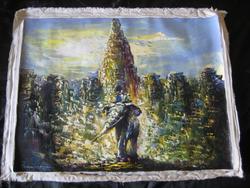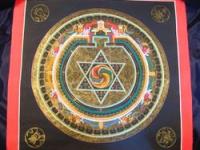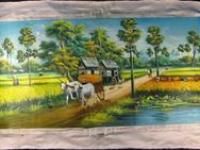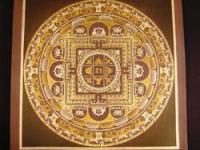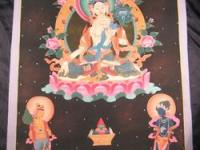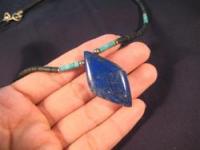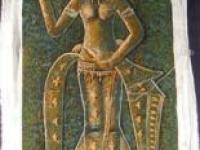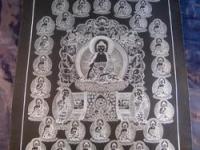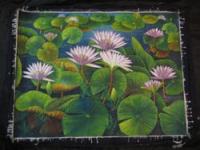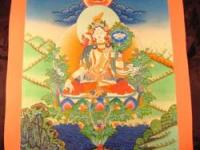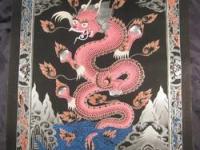This is a stunning depiction of an elephant trek through the Ankor wat complex in Siem Reap Cambodia. I don't think my words can do this painting justice. It is really breath taking the skill, proportion, surrealism the artist deonstrated in his art here. The feeling I get from looking at it is the same I felt the first time I saw the temple complex for the first time in person.
This painting will bring back fond memories of one's visit there or definately inspire one to go if they have never been.
Some history of Ankor Wat:
The Ankor period began in 802 A.D when King Jayavarman the second returned from being exiled to Java and reclaimed his throne. He founded his capital the city of Ankor which flourished and 200 years later under King Suryavarman the second Ankor Wat was contructed as his burial shrine. 50,000 men worked the main temple to completion in 37 years. However future rulers continued building countless other smaller temples and monuments. Including the other two large temples of Ankor Tom and Bayon ( temple of a hundred Buddha heads ).
Incidentally two factors that gave rise to such a powerful civilization at the time was an effective political system and an advanced irrigation system to control water from the Mekong river for agriculture. An extensive road system extended up to modern day Laos, across into Thailand and down into southern Vietnam.
Both Buddhism and Hinduism had influence in Khmer society. Hinduism played an important role in Khmer civilization as the Ankor Monarchs adopted as deva-raja, or “god-king” by which the king was revered as an incarnation of the god Shiva. Most temples of Ankor are dedicated to either Shiva or Vishnu. Mahayana Buddhism also played a role in the influence of the society.
About five centuries ago the Khmer Ankor civilization vanished with an invasion from Thailand and when it is believed that the capital was relocated to Pnom Penn. The city remained lost in the jungle until it was rediscover in 1860 by French botanist Henri Mouhot who was exploring the Cambodian jungles. Even most locals believed the temple city was a myth.
Ankor Wat stands as one of mankind’s greatest achievements.
This painting is really a gem and I know whoever gets this painting will love it.
No noticeable flaws
Size: 40" wide and 23.7" tall ( 101.6 cm tall and 60.2 cm tall not including white border
The painting is currently with me in Thailand and will be shipped from here before June 15th. After that I will be shipping it from the USA.
This painting will bring back fond memories of one's visit there or definately inspire one to go if they have never been.
Some history of Ankor Wat:
The Ankor period began in 802 A.D when King Jayavarman the second returned from being exiled to Java and reclaimed his throne. He founded his capital the city of Ankor which flourished and 200 years later under King Suryavarman the second Ankor Wat was contructed as his burial shrine. 50,000 men worked the main temple to completion in 37 years. However future rulers continued building countless other smaller temples and monuments. Including the other two large temples of Ankor Tom and Bayon ( temple of a hundred Buddha heads ).
Incidentally two factors that gave rise to such a powerful civilization at the time was an effective political system and an advanced irrigation system to control water from the Mekong river for agriculture. An extensive road system extended up to modern day Laos, across into Thailand and down into southern Vietnam.
Both Buddhism and Hinduism had influence in Khmer society. Hinduism played an important role in Khmer civilization as the Ankor Monarchs adopted as deva-raja, or “god-king” by which the king was revered as an incarnation of the god Shiva. Most temples of Ankor are dedicated to either Shiva or Vishnu. Mahayana Buddhism also played a role in the influence of the society.
About five centuries ago the Khmer Ankor civilization vanished with an invasion from Thailand and when it is believed that the capital was relocated to Pnom Penn. The city remained lost in the jungle until it was rediscover in 1860 by French botanist Henri Mouhot who was exploring the Cambodian jungles. Even most locals believed the temple city was a myth.
Ankor Wat stands as one of mankind’s greatest achievements.
This painting is really a gem and I know whoever gets this painting will love it.
No noticeable flaws
Size: 40" wide and 23.7" tall ( 101.6 cm tall and 60.2 cm tall not including white border
The painting is currently with me in Thailand and will be shipped from here before June 15th. After that I will be shipping it from the USA.
Payment Methods


Shipping
$18.00
Please Login or Register first before asking a question.
